Price continues to be range bound. A reliable continuation pattern, a pennant, may be forming. The flag pole is used to calculate a target.
Summary: There is an upwards trend in place that is very extreme. Conditions are overbought. This can continue while price moves a considerable distance further, or a trend change may occur at any time now. Caution is warranted. Risk management is essential.
The bullish Elliott wave count expects this consolidation may continue for another couple of weeks or so. It may be relatively shallow and may include a new high above 1,533.34. After an upwards breakout, the target would be at 1,693.
The bearish Elliott wave count now expects this may be the last consolidation within the upwards trend, and the consolidation may continue for another week or so. It may be relatively shallow and may include a new high above 1,533.34. After an upwards breakout, the target for the trend to finally end would be at 1,572.
A classic analysis target using a possible pennant pattern is at 1,669.
Grand SuperCycle analysis is here.
Monthly charts were last published here with video here.
BEARISH ELLIOTT WAVE COUNT
WEEKLY CHART
It is possible that Super Cycle wave (b) is completing as a double zigzag.
The first zigzag in the double is labelled cycle wave w. The double is joined by a three in the opposite direction, a triangle labelled cycle wave x. The second zigzag in the double is labelled cycle wave y.
Cycle wave y now fits best as an incomplete zigzag.
The purpose of the second zigzag in a double is to deepen the correction. Cycle wave y has achieved this purpose.
1,450.65 is the high of intermediate wave (1) within primary wave C. A new low below 1,450.65 could not be part of intermediate wave (4), so at that stage the structure of primary wave C would have to be compete. A new low below 1,450.65 would add some confidence in a trend change.
1,401.30 is the start of primary wave C. A new low below this point could not be a second wave correction within primary wave C, so at that stage primary wave C would be confirmed as over.
A new low below 1,346.45 would invalidate the bullish wave count below and add confidence to a bearish wave count.
Two daily charts below look at the zigzag of cycle wave y in two different ways.
DAILY CHART
Both bearish wave counts at the daily and weekly chart level see cycle wave y beginning at the same point at 1,266.61 on the 24rd of April 2019. Thereafter, this wave count looks at the zigzag of cycle wave y differently.
Within cycle wave y, the triangle that ended on the 17th of July may have been primary wave B. Primary wave C may have begun there. Primary wave C must subdivide as a five wave structure; it may be completing as an impulse.
Intermediate waves (1), (2) and (3) within the impulse of primary wave C may be complete. Intermediate wave (3) for this wave count is just 0.33 longer than 2.618 the length of intermediate wave (1).
Intermediate wave (4) may be unfolding sideways as a small consolidation to continue for another week or so. Intermediate wave (2) completed as a deep 0.98 zigzag lasting 9 sessions. Intermediate wave (4) may exhibit alternation as a flat, triangle or combination. Within those structural possibilities, any one of an expanded flat, running triangle or combination may include a new high above 1,533.34. A new high above 1,533.34 would invalidate the alternate bearish wave count and leave this wave count valid.
Intermediate wave (4) may not move into intermediate wave (1) price territory below 1,450.65.
HOURLY CHART
Intermediate wave (4) may be any corrective structure. So far it looks least likely to be a zigzag. It would most likely continue further sideways as a flat, combination or triangle.
The first wave of minor wave A may be a complete zigzag.
If intermediate wave (4) unfolds as a flat correction, then within it minor wave B must subdivide as a corrective structure and at its terminus must retrace a minimum 0.9 length of minor wave A. Minor wave B may make a new high above the start of minor wave A at 1,533.34 as in an expanded flat.
If intermediate wave (4) unfolds as a triangle, then within it minor wave B must subdivide as a corrective structure. There is no minimum length required for minor wave B within a triangle. It may also make a new high above the start of minor wave A at 1,533.34 as in a running triangle.
If intermediate wave (4) unfolds as a combination, then the first structure may be complete as a zigzag which would be labelled minor wave W. The double may then be joined by a three in the opposite direction to be labelled minor wave X, which would be incomplete and would most likely subdivide as a zigzag. Minor wave X would most likely be a deep correction and may make a new high above the start of minor wave W at 1,533.34.
ALTERNATE DAILY CHART
Cycle wave y may be a complete zigzag.
If there has been a trend change, then downwards movement should unfold as a five wave structure from the high. Downwards movement should exhibit strength in either or both of rising ATR or volume.
No second wave correction within a new downwards trend may move beyond the start of its first wave above 1,533.34.
BULLISH ELLIOTT WAVE COUNT
WEEKLY CHART
This wave count sees the the bear market complete at the last major low for Gold in November 2015.
If Gold is in a new bull market, then it should begin with a five wave structure upwards on the weekly chart. However, the biggest problem with this wave count is the structure labelled cycle wave I because this wave count must see it as a five wave structure, but it looks more like a three wave structure.
Commodities often exhibit swift strong fifth waves that force the fourth wave corrections coming just prior and just after to be more brief and shallow than their counterpart second waves. It is unusual for a commodity to exhibit a quick second wave and a more time consuming fourth wave, and this is how cycle wave I is labelled. This wave count still suffers from this very substantial problem, and for this reason the bearish wave count is still considered because it has a better fit in terms of Elliott wave structure.
Cycle wave II subdivides well as a double combination: zigzag – X – expanded flat.
Cycle wave III may have begun. Within cycle wave III, primary waves 1 and 2 may now be complete. Primary wave 3 has now moved above the end of primary wave 1 meeting a core Elliott wave rule. It has now moved far enough to allow room for primary wave 4 to unfold and remain above primary wave 1 price territory. Primary wave 4 may not move into primary wave 1 price territory below 1,346.45.
Cycle wave III so far for this wave count would have been underway now for 53 weeks. It is beginning to exhibit some support from volume and increasing ATR. This wave count now has some support from classic technical analysis.
The channel drawn about cycle wave III is an Elliott channel. Primary wave 4 may find support about the lower edge.
DAILY CHART
Primary wave 3 may now be a complete impulse. The structure of intermediate wave (5) is now complete.
Primary wave 4 may not move into primary wave 1 price territory below 1,346.45.
Primary wave 4 may last about four to ten weeks. It may unfold as any one of more than 23 possible Elliott wave corrective structures. Primary wave 4 may end within the price territory of the fourth wave of one lesser degree; intermediate wave (4) has its range from 1,438.43 to 1,382.10. It is also possible that it may be more shallow than this.
Within the price territory of intermediate wave (4), from 1,438.43 to 1,382.10, lies the 0.382 Fibonacci Ratio of primary wave 3 at 1,431.45. This is still a possible target for primary wave 4.
HOURLY CHART
It is possible that primary wave 4 may be more brief and shallow than originally expected.
Primary wave 4 may be unfolding sideways as a flat, combination or triangle. This wave count for the short term is essentially the same as the hourly chart for the bearish wave count now, with the exception of the degree of labelling. This wave count is labelled one degree higher.
Both bull and bear wave counts now expect that a fourth wave is continuing sideways.
TECHNICAL ANALYSIS
MONTHLY CHART

Click chart to enlarge. Chart courtesy of StockCharts.com.
Gold has effected an upwards breakout above multi-year resistance and above the cyan bear market trend line. Price is now at strong resistance about 1,525.
The new high in price above prior highs for March / April 2018 have not been matched by new highs for On Balance Volume. This divergence is bearish and supports a bearish Elliott wave count. This divergence may be given a little weight because it is strong and evident on the monthly chart.
WEEKLY CHART
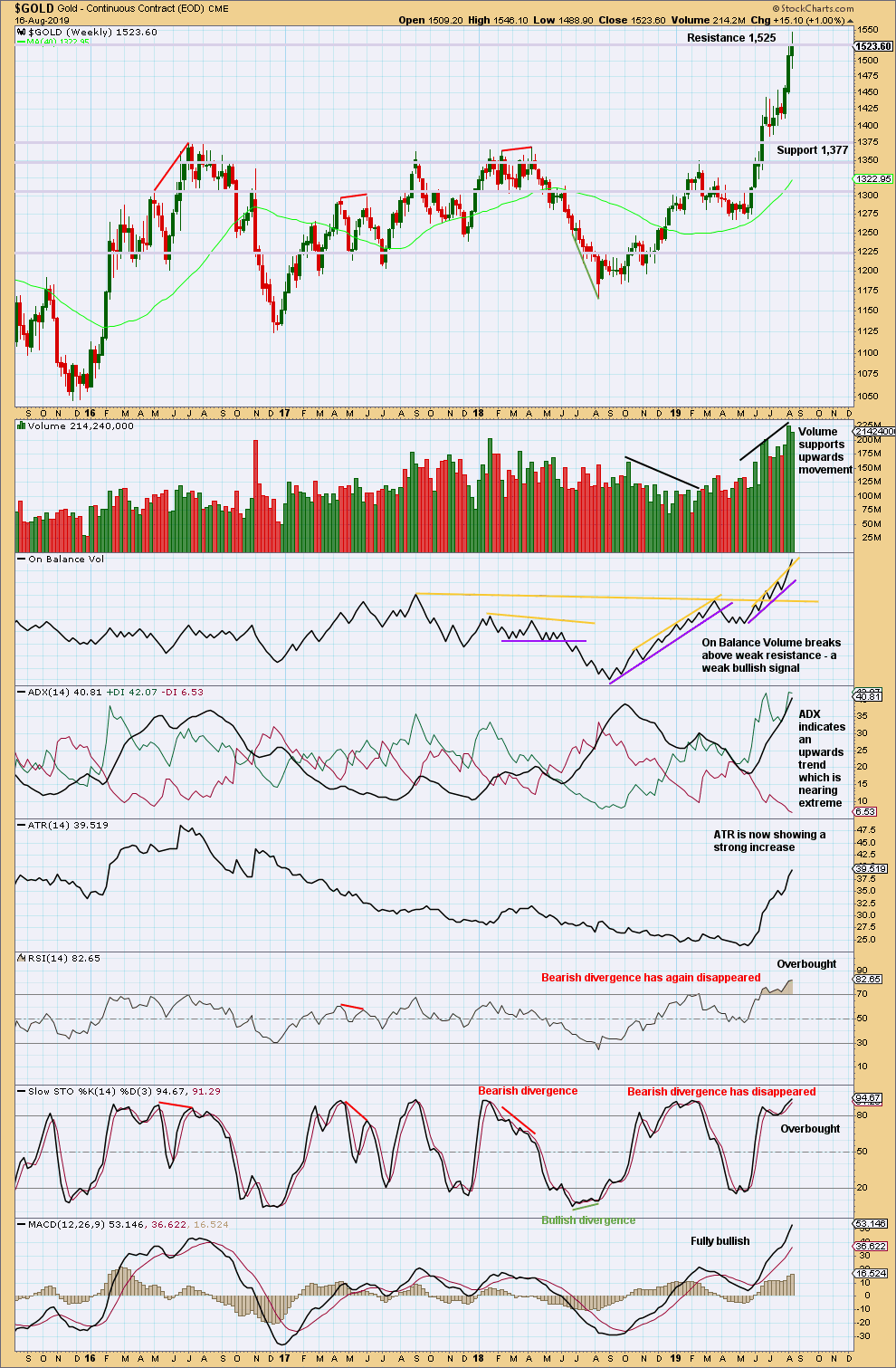
Click chart to enlarge. Chart courtesy of StockCharts.com.
When trends for Gold reach extreme, they can continue still for a few weeks and price can continue for a considerable distance.
When both ADX and RSI reach extreme together, then that is sometimes where a trend ends.
RSI at overbought on the weekly chart is a warning to be cautious; the trend is overbought, but at this stage there is no evidence of a trend change.
The signal last week from On Balance Volume is weak because the resistance line breached has a strong slope and is not long held.
DAILY CHART
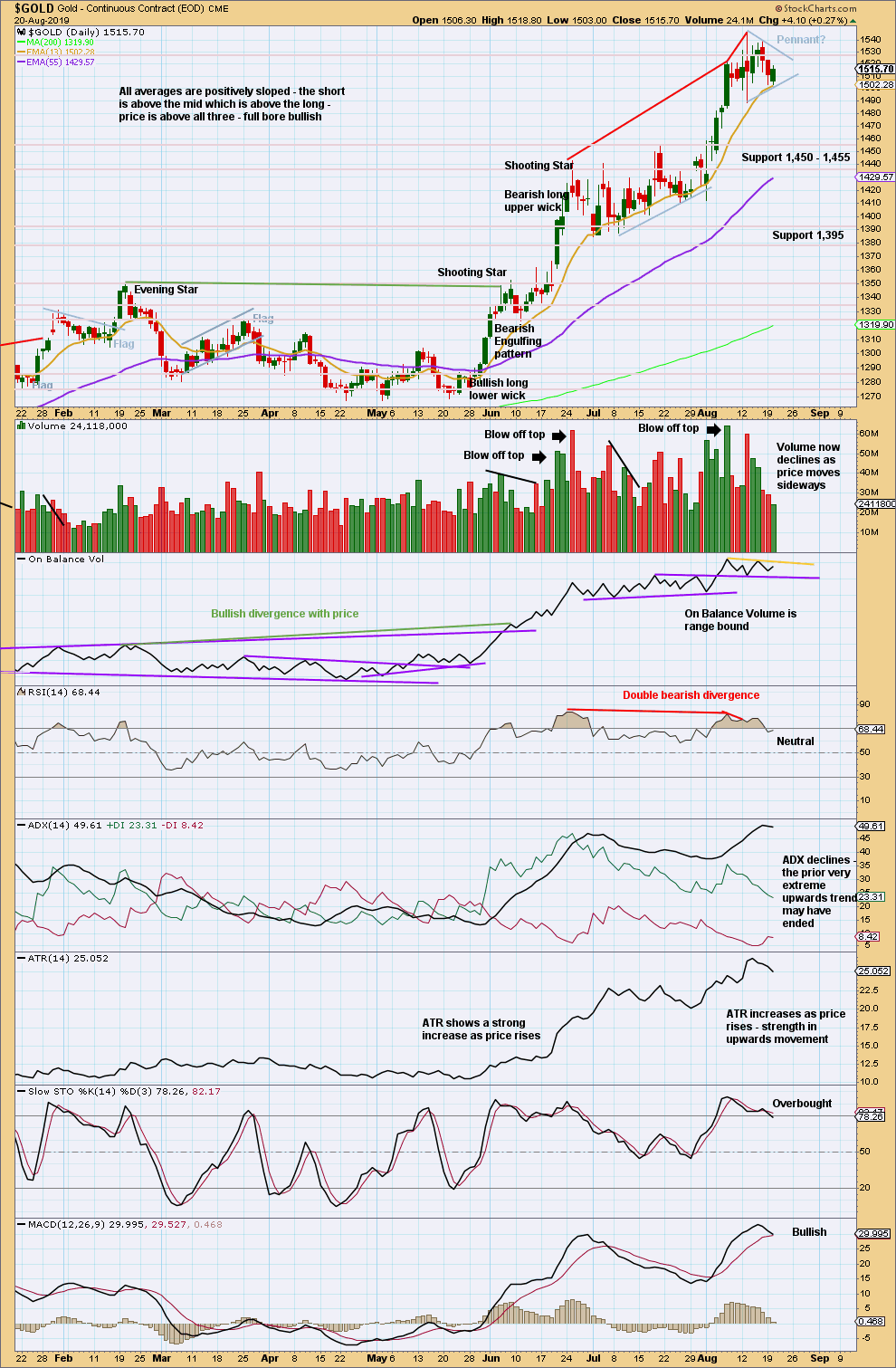
Click chart to enlarge. Chart courtesy of StockCharts.com.
Evidence of a bearish candlestick pattern is a strong indicator of a minor or major high in place. The short to mid-term volume profile can be variable. Blow off tops are uncommon at minor to major highs, and are equally as likely to be either right at the high or up to a few sessions prior. RSI at overbought increases the probability of a minor to major high occurring, but it can persist for weeks before price turns. ADX likewise can persist at extreme for weeks before price turns and may not even reach extreme at minor or major highs. On Balance Volume is unlikely to exhibit a signal at a high but when it does it may increase the probability of a minor or major high having just occurred.
Currently, there is no bearish candlestick reversal pattern at the last high, there was a blow off top 4 sessions prior to the last high, ADX has reached very extreme, RSI also has reached overbought and exhibits bearish divergence with price, and On Balance Volume has given no signal. The probability that a major or minor high occurs here is heightened, but not certain. Extreme caution for long positions is warranted.
While price remains above the last swing low at 1,412.10, there is a series of higher highs and higher lows and an upwards trend in place. A new low below 1,412.10 would be a lower low and would confirm a trend change.
For the short term, a small pennant pattern may be forming. These are reasonably reliable continuation patterns. The target would be at 1,669.
GDX WEEKLY CHART
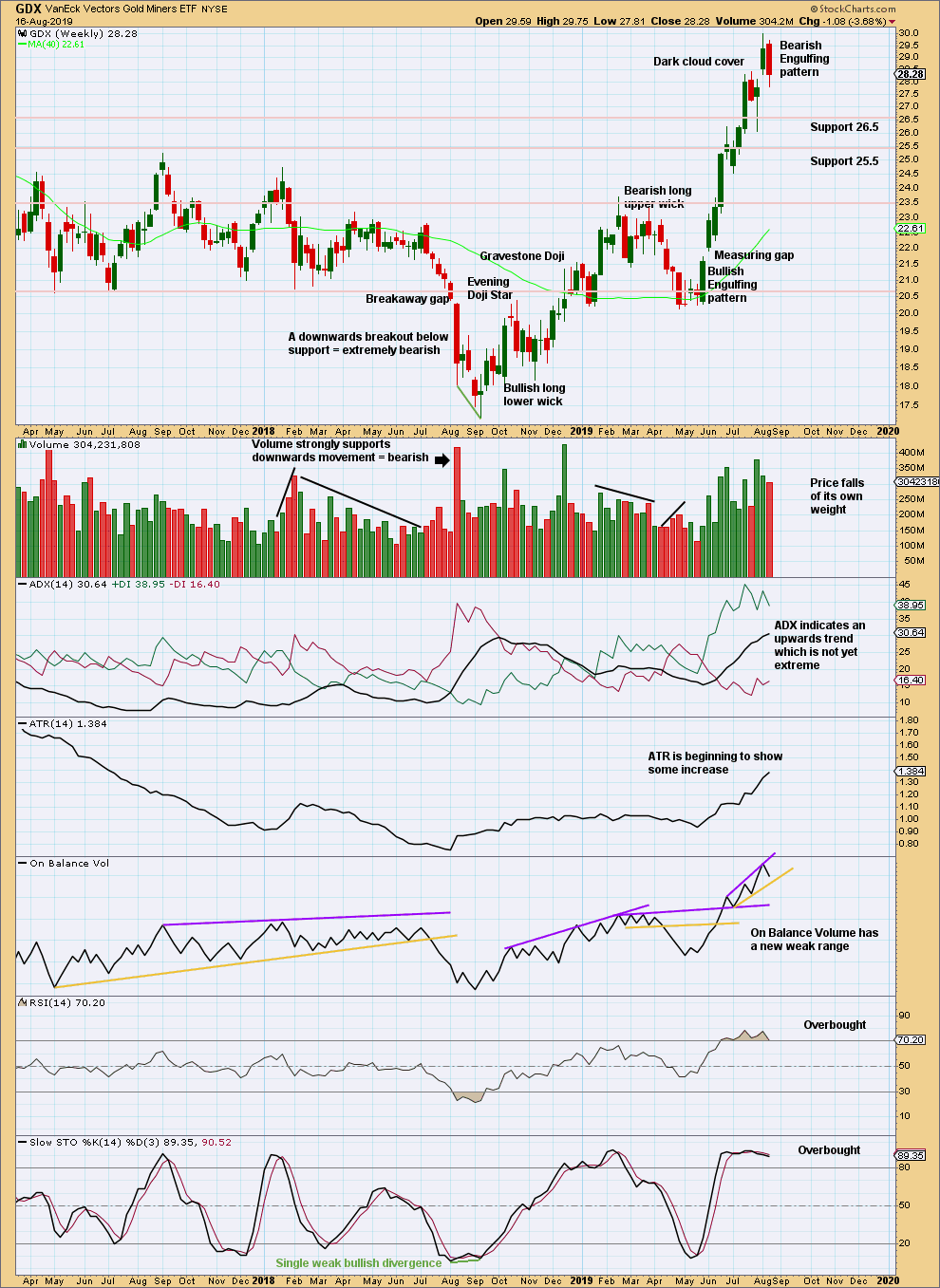
Click chart to enlarge. Chart courtesy of StockCharts.com.
A strong Bearish Engulfing candlestick pattern is a strong warning that the upwards trend may now be over. A larger consolidation or a trend change may occur here.
GDX DAILY CHART
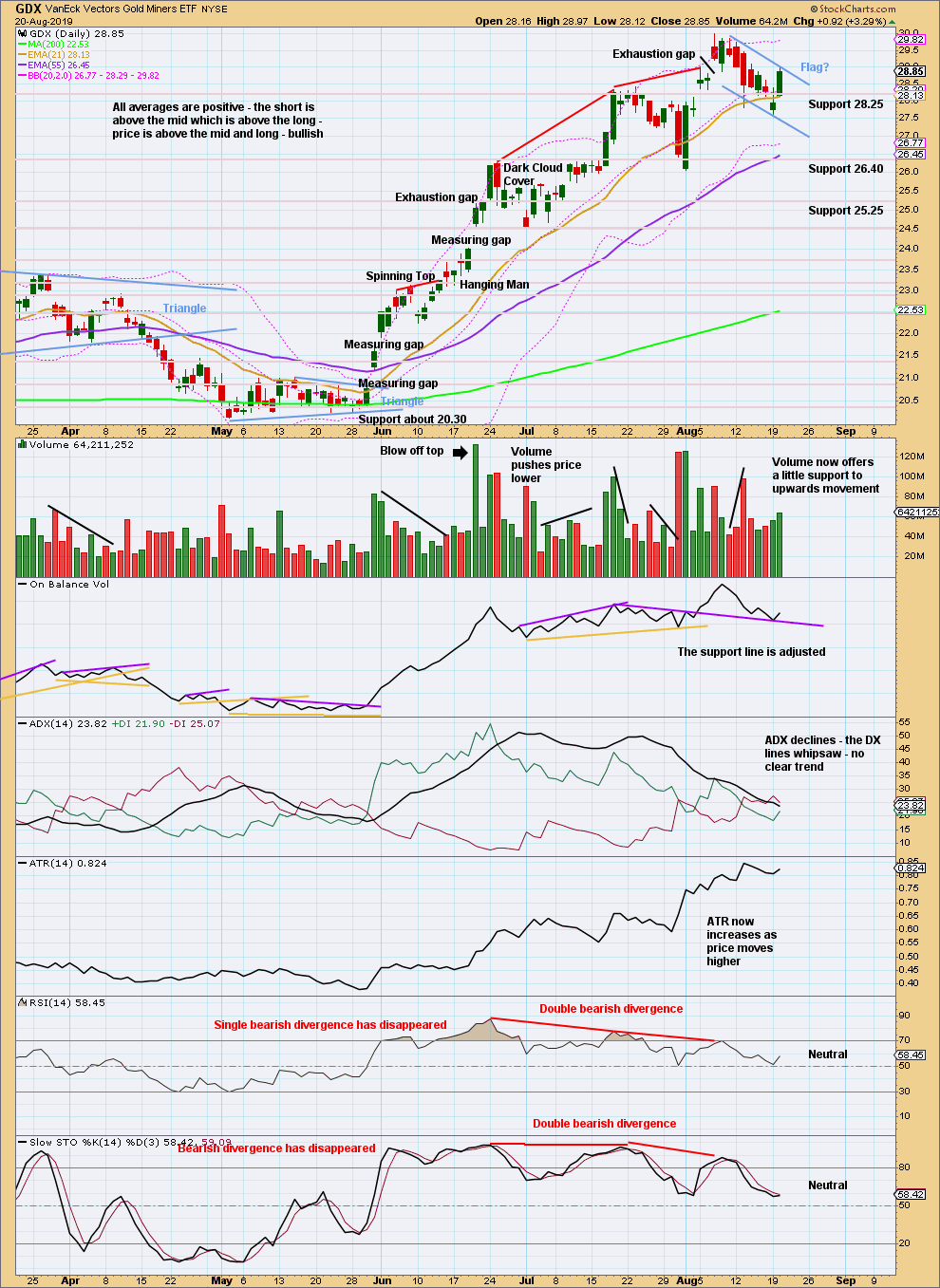
Click chart to enlarge. Chart courtesy of StockCharts.com.
A small flag may be forming. The target using the flag pole would be at 32.76.
The last swing low was at 26.04. A new low below this point would confirm a trend change.
Published @ 10:28 p.m. EST.
—
Careful risk management protects your trading account(s).
Follow my two Golden Rules:
1. Always trade with stops.
2. Risk only 1-5% of equity on any one trade.
—
New updates to this analysis are in bold.

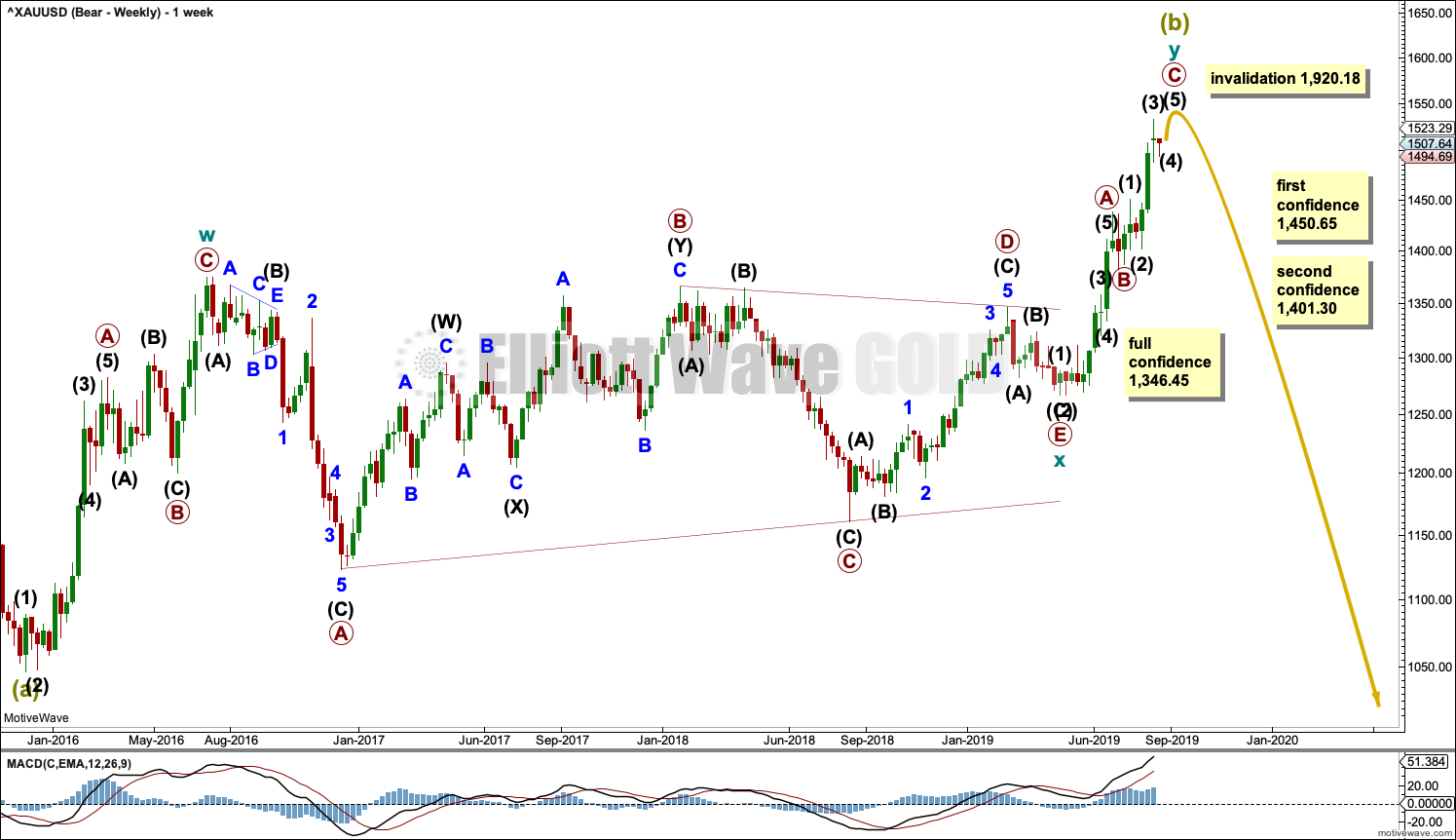
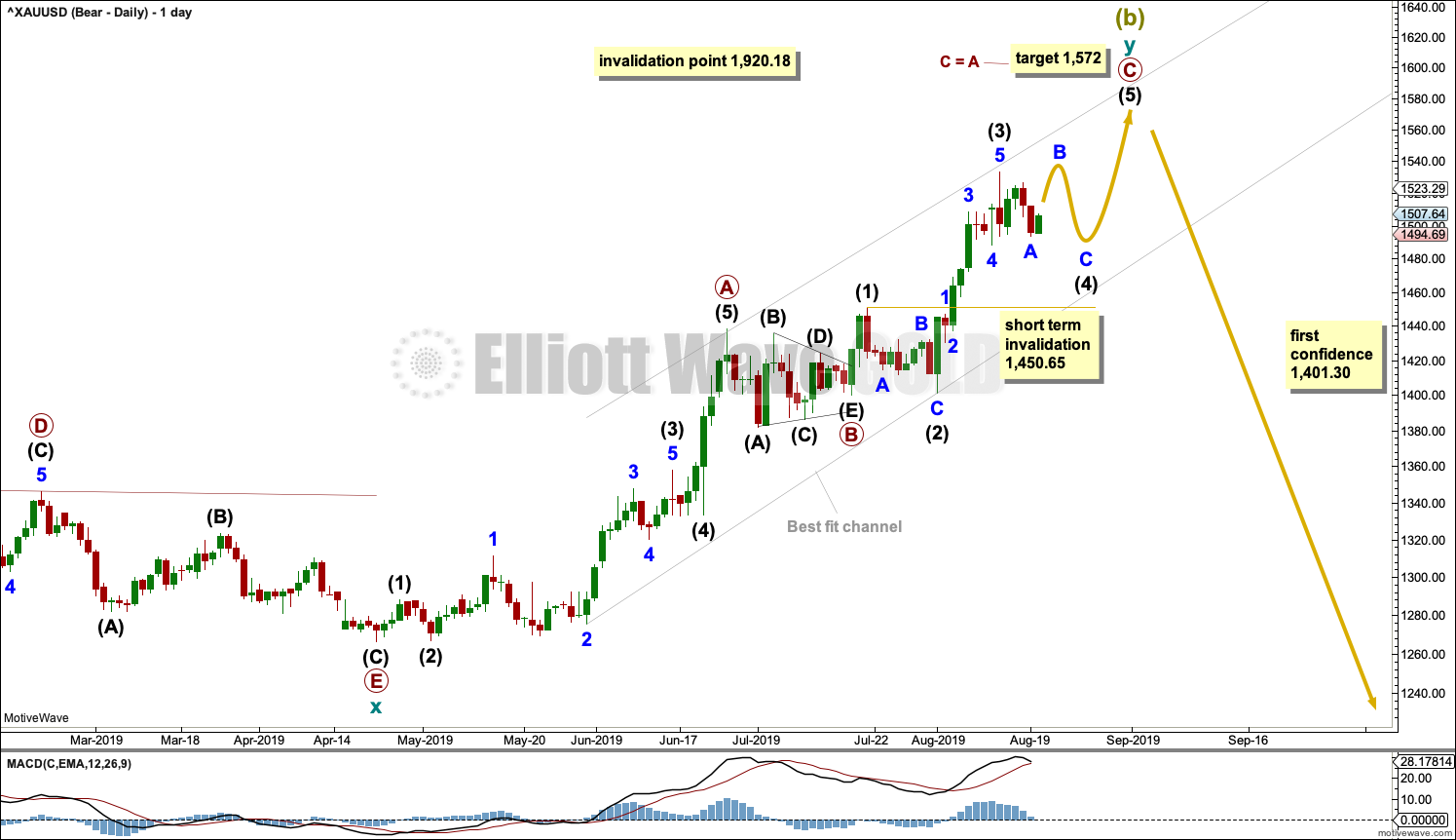

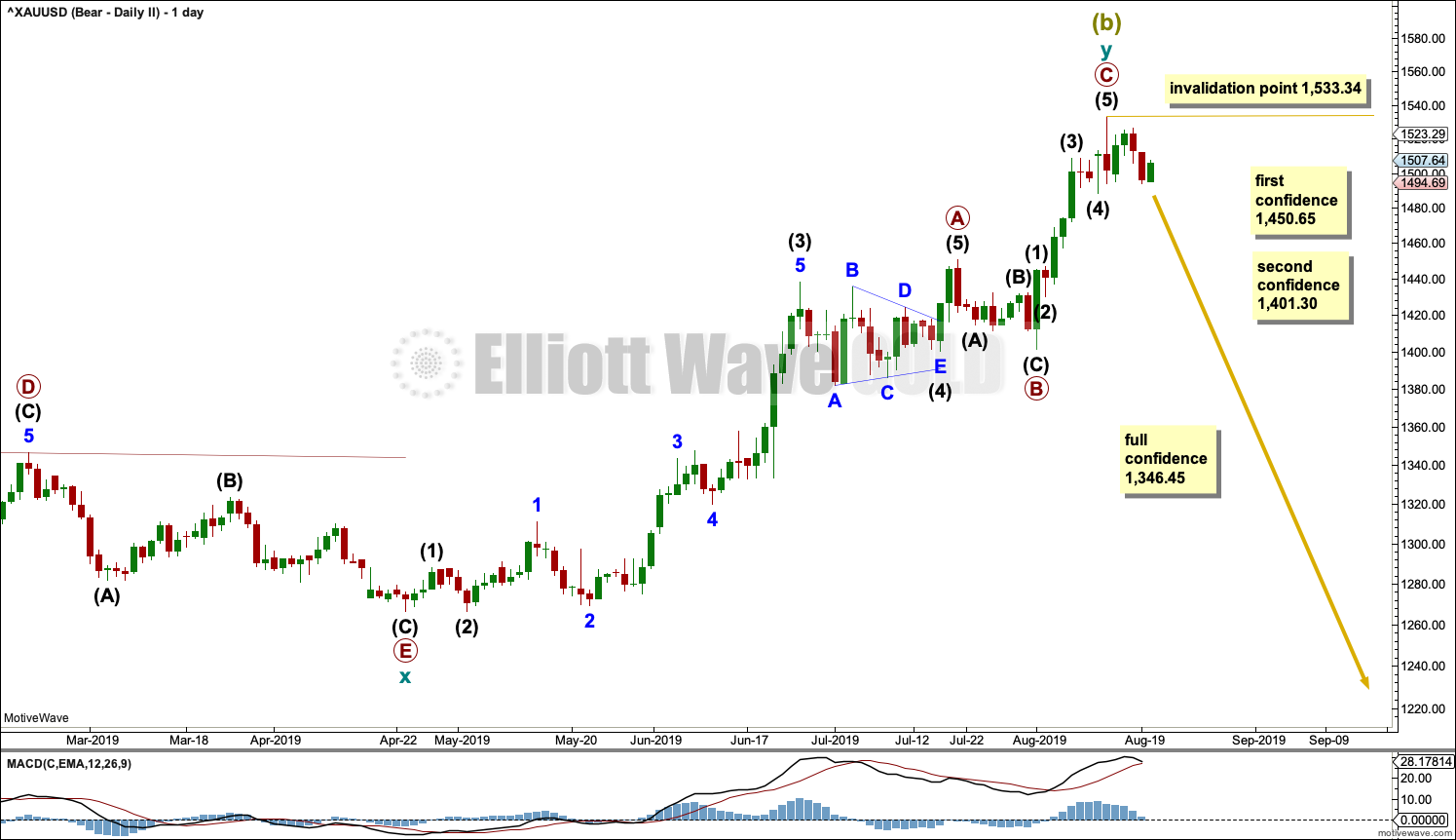


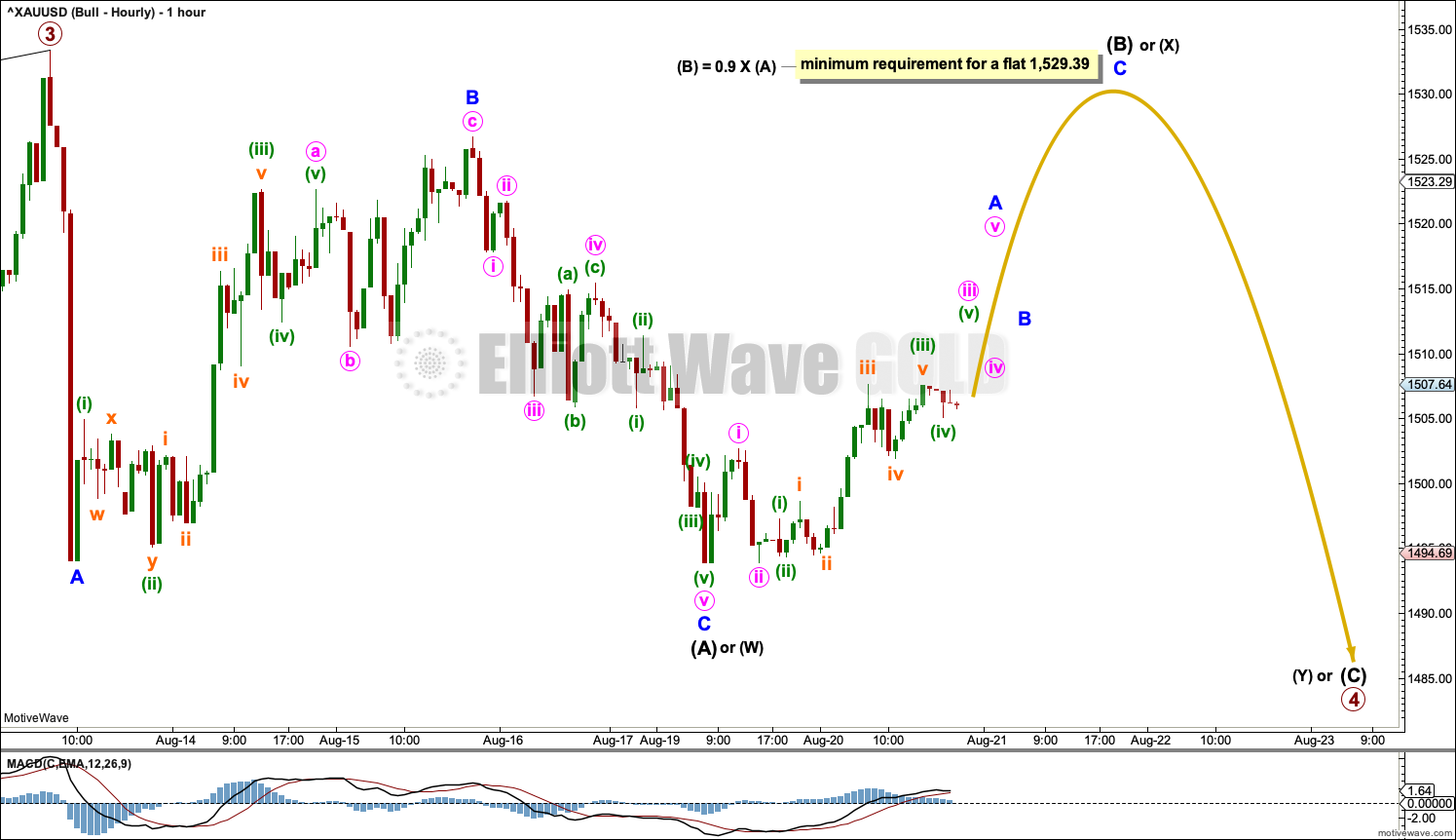
Hourly bullish chart updated